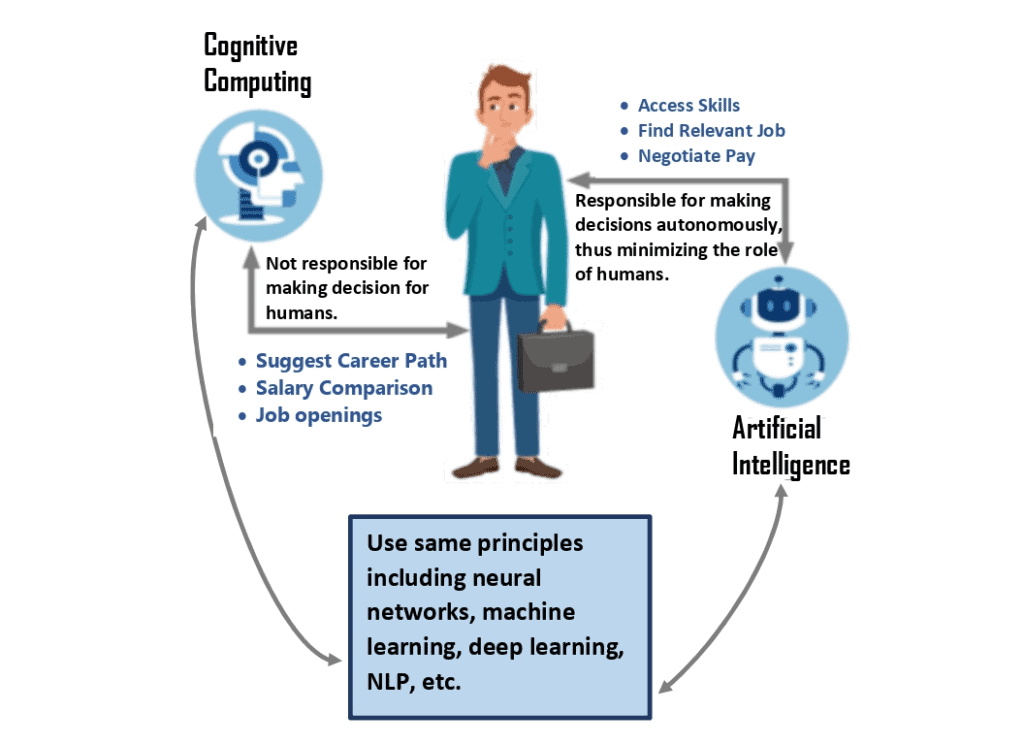1. 概述
在本文中,我们将深入探讨两个重要概念:人工智能(AI) 和 认知计算(Cognitive Computing)。并重点分析它们之间的异同点,帮助读者更清晰地理解这两个术语的本质。
2. AI 与认知计算
人工智能是一个涵盖范围非常广的术语,指的是所有能够让机器模拟人类认知行为的技术。其中包括机器学习(ML)、深度学习(DL)、神经网络、图像识别、自然语言处理(NLP)等多个领域。
认知计算常常被误认为是人工智能的一种,因为它也使用了类似的底层技术。但两者在输出结果和与人类交互方式上存在显著差异。
我们先分别介绍这两个概念的核心内容,然后再做对比分析。
2.1 人工智能(Artificial Intelligence)
当一个系统能够模拟人类大脑常见的认知行为,例如学习、推理、问题解决等时,我们称之为“人工智能”。
AI 是指“机器模拟人类认知过程”的技术总称。它包括知识获取、规则学习、推理判断以及自我修正能力。
✅ AI 的目标是让机器具备超越人类的智能水平,在准确性、效率、决策速度等方面表现更优。
✅ AI 减少了对人类的依赖。例如智能客服(Chatbot)就可以使用 AI 技术自动处理客户常见问题,从而减轻人工客服压力,提高响应效率和客户满意度。
2.2 认知计算(Cognitive Computing)
认知计算的核心目标是辅助人类做出更明智的决策,而不是完全替代人类决策。
这类系统处理大量数据,进行重复性分析,并在新数据输入后不断修正结论。它依赖于自学习算法,结合数据挖掘、语音/图像识别、自然语言处理等 AI 技术来解决复杂问题。
例如:
- 金融行业使用认知计算帮助分析客户需求,推荐合适产品;
- 医疗行业借助认知系统辅助医生诊断病情,制定个性化治疗方案。
这些系统可以像人类一样思考、学习并与人互动,具备处理符号和抽象概念的能力:

举个例子:
设想一个人正在考虑换工作:
- AI 系统会自动评估他的技能,找到匹配岗位,协商薪资,并代表他做出最终决定;
- 认知系统则会提供关键信息,如所需进一步教育、薪资对比、空缺岗位推荐等,最终决策仍由用户自己做出。
因此,我们可以总结:
- AI 是让机器代替人做决策;
- 认知计算是让机器辅助人更好地做决策。
3. 认知计算 vs AI:关键对比
| 对比维度 | 人工智能(AI) | 认知计算(Cognitive Computing) |
|---|---|---|
| 技术基础 | 使用 ML、DL、神经网络、NLP 等技术 | 同样使用 AI 技术,但更强调人机协作 |
| 目标 | 自动化流程,替代人类决策 | 增强人类智能,辅助人类决策 |
| 方法 | 分析大量数据,找出最优解并直接执行 | 分析数据,提取有用信息供人类参考 |
| 关注点 | 以解决问题为核心 | 以提升人类判断能力为核心 |
| 交互方式 | 独立决策,无需人工干预 | 提供信息,最终由人决策 |
| 应用场景 | 医疗、制造、客服等以自动化为目标的行业 | 金融、市场、政务、医疗等需要深度分析与辅助决策的领域 |
4. 总结图示
下图清晰展示了 AI 与认知计算在核心目标和交互方式上的区别:

5. 总结
本文重点介绍了人工智能(AI)和认知计算的基本概念,并从技术基础、目标、方法、交互方式和应用场景等维度进行了对比分析。
✅ AI 的核心是“替代人类做决策”,适用于自动化、效率优先的场景;
✅ 认知计算的核心是“辅助人类做决策”,适用于需要结合人类经验与数据分析的复杂场景。
⚠️ 注意:不要混淆这两个概念。虽然它们都使用了 AI 技术,但目标和应用场景完全不同。理解这一点,有助于我们在实际项目中选择合适的技术方案。